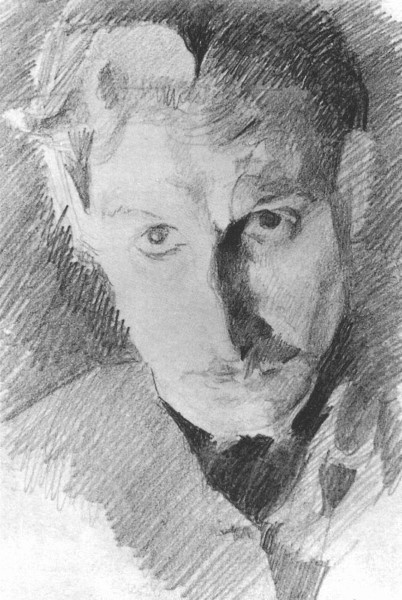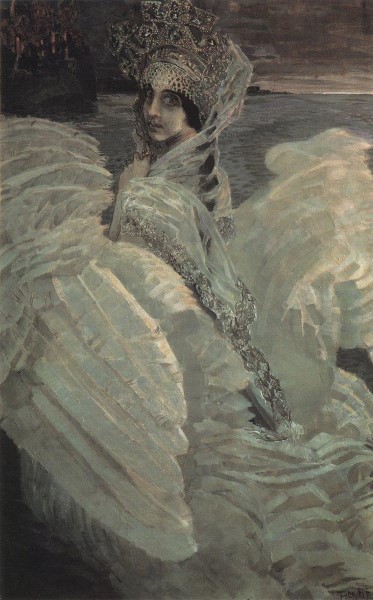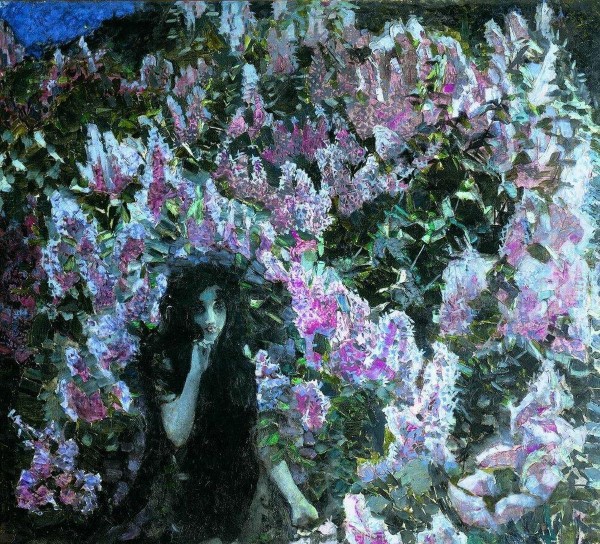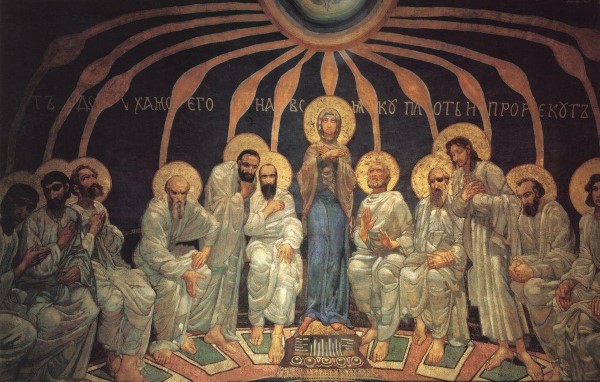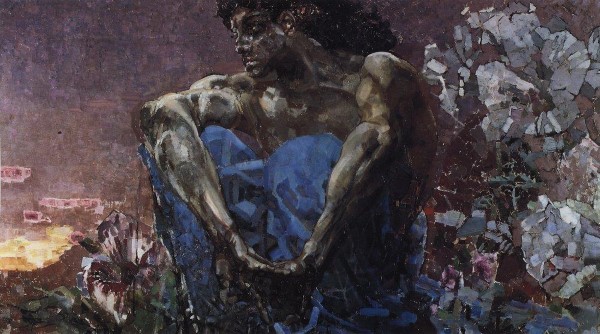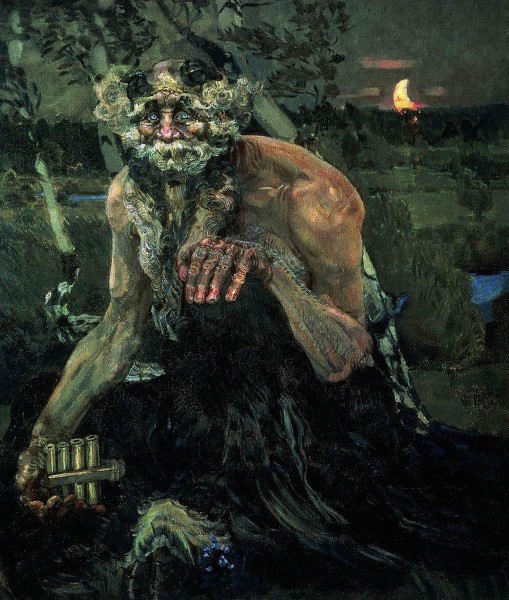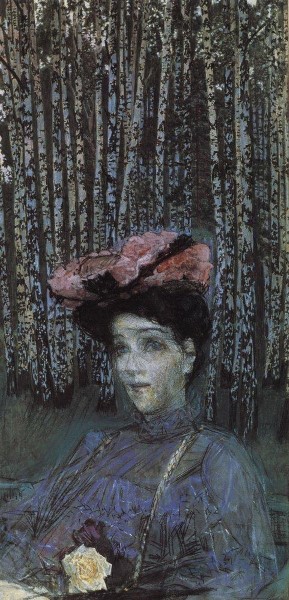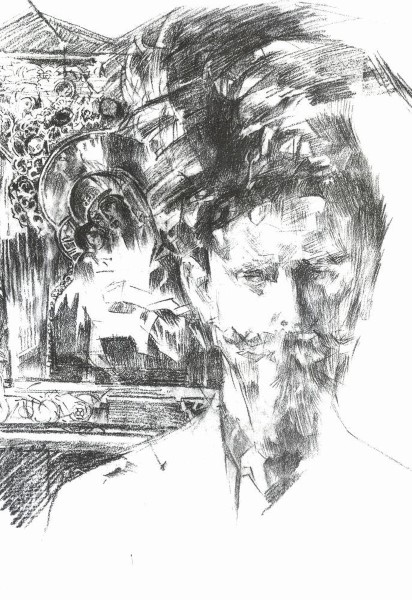Although there are many portraits of Mikhail Aleksandrovich Vrubel, including a few self portraits, his face seems to be unfamiliar to us. Looking at his paintings, we imagine a romantic figure with a proud profile and vivid eyes. People, who have known the artist, describe him completely other way: not a very tall blonde man, friendly, communicable, a bit fussy…
An aspiring artist L. Kovalskiy from Kiev described his first encounter with 24-year-old Vrubel, who just came to start working on Kirillovskaya church: “The silence of the night, full absence of anybody, except for swallows, flying and twittering in the sky. I was calmly imagining, as well as I could, my 30-verst landscape, but I was forced to turn back by silent steps and fixed look. The scene was more than exciting: against primitive hills of Kirillovskoye behind my back stood a fair, almost white young blonde man with a very notable head, small moustache, almost white. Not too tall, very balanced body type, dressed in black velvet suit, short underdrawers and half-boots. No one dressed like that in Kiev and I was impressed. It was a young Venetian man from the paintings of Tintoretto and Titian”.
Self portrait, 1885
The Vrubels were not rich; as a child, Mikhail born in Omsk had to move from town to town often, as his father was a military officer. At the age of 18 Vrubel was admitted to the Faculty of Law of St. Petersburg University. Even though he was interested in painting from an early age, it appears that he didn’t think about painting professionally at that time.
They say that Vrubel’s decision to enter the Arts Academy after the university was influenced by his interest of Kant’s philosophy and aesthetics. Even in his early years, Vrubel highly valued his gift, and according to Kant, a genius has a special mission to create, as far as he instinctively realizes the nature of art. However, there is a more or less ordinary explanation of how Vrubel became a professional artist. Being a student, he was involved in the art environment, prevailing in his unkle's house (his stepmother’s brother – Vrubel’s mother died, when Mikhail was three years old). A famous teacher Nikolai Vessel was acquainted with many representatives of arts intelligentsia, especially from musical and theatre spheres (for example, Musorgskiy among them). This has left a stamp on Vrubel’s art taste – his paintings and story plots are often theatrical.
Swan Princess, 1900
As Bohemian life demanded much money, Mikhail had to work extra hours as a tutor, although he did it in good families. For five years, he worked in a rich family of a sugar-works owner Papmeley, and they say he was almost a member of the family – went to opera with them, visited their summer cottage, allowed himself wine.
Vrubel was quite an expansive man, often impractical and hotheaded. He could work on one painting for months, started but did not finish his works, gave them as presents, destroyed or undersold them. Sometimes he made new works on old canvas. For instance, famous “Pan” was painted over a scraped off wife’s portrait and “Fortuneteller” – over an unfinished portrait of N.Mamontov.
“Once he sold a wonderful picture from “The Stone Guest” – “Don Juan”, for 3 Rubles, just that. Bought white kid gloves, tried them on and threw them away, saying :”How vulgar they are”, Konstantin Korovin recalled.
At the age of 24, Vrubel enters the Imperial Art Academy. Although, 1980s in Russia were still the times of neo-academic salon painting, it was not a decadent period. Itinerants were creating at that period; stars of the following generation were already starting working – Levitan, Serov, Korovin, Nesterov.
Lilac, 1900
Vrubel’s teacher at the Academy was Pavel Chistyakov – a wonderful teacher, whose students were Repin, Surikov, Polenov, Vasnetsov, Serov… this was the artistic circle, where young Vrubel belonged. Even from the start, a specific romantic note appeared in his works, which became his distinctive feature, remember his demons, “Dream Princess” or “Swan Princess“.
Many Vrubel’s works are monumental. It is not even about the sizes of his paintings, even though ordinary visitors are usually struck by enormous “Dream Princess” and other big paintings that we see in the Vrubel’s hall of the Tretyakov Gallery. It is more about the special monumental plastics of his paintings and a special Vrubel’s brushstroke. The first serious work of young Vrubel was his paintings in the ancient Kirillovskaya church in Kiev. This work did not do him famous, but it was duly appreciated later.
The Descent of the Holy Spirit on the Apostles, 1885
He worked in Kiev, visited Venice, returned back to Kiev. Vrubel liked ancient Kiev, but lived there quite modestly. He had to work extra hours painting ornaments (his second work at Vladimir temple) and teaching. In Moscow, where he came in 1889 for a while to see his friends, but stayed for 12 years, he happened to be in the middle of artistic life.
At the time, a circle around arts patron Savva Mamontov was forming, and Vrubel became a full member of it. After two months of their first encounter, he moved in the Mamontov’s house and became an inside man in this hospitable family. Thanks to Mamontov, Vrubel started to get good orders and Kiev poverty became history. In 1891, he was offered to illustrate the collected works of Lermontov. He took the order willingly, especially since he started to think over the Demon’s image in Kiev. Thanks to precisely this image, we do know Vrubel now.
Demon, 1890
In May 1890, he wrote about the new image, which occupied all his thoughts to his sister: “I have been working on the Demon for more than a month, well, not the monumental one, which I am going to paint later, but the “demonic” – a half naked, winged, sadly thoughtful figure is sitting, hugging its knees, dawn in the background, observing a flower meadow, and branches, bending under flowers, reach it”. This is so-called “Sitting Demon” – the firs image from the big series, painted and created by Vrubel.
"Demon" was widely discussed in public. Many have accused the artist of creating ugliness, laughed at his new painting, and this refers to those, determining the tastes of the epoch, including the members of the Arts Academy, not about the ordinary people. But some have appreciated the artist's high mastership and expression of the image created by him: "I was fourteen or fifteen then. We always had new books at home and we bought Lermontov's illustrated works published by Knebel. I was struck by Vrubel's "Demon". They were the biggest attraction, as well, when my sophisticated mother showed the new illustrations of Lermontov to her friends. There was no end to the laughter and silly jokes that emerged as a reaction to everything new. I was hurt in a brand new way; I could not allow the insult anymore, took Lermontov away and hid it under the mattress. They were looking for it for a long time, but did not find it." recalled L. Block-Mendeleeva.
Now “Demon” is almost a classic work – when we think of Lermontov’s hero, we think of the Vrubel’s painting right away. Nonetheless, over fifty years no one could embody this mysterious poet’s image.
Pan, 1899
We know Mikhail Vrubel also as a poet of Russian fairy epic. Swan Princess, Mikula Selyanovich, Pan are among the most recognized images. In 1900, Vrubel was awarded a gold medal for his painting “Volga Svyatoslavich and Mikula Selyanovich” at the Paris World Fair.
It was important for Vrubel to show “the national” in art. “I am in Abramtsevo now and I am poured over, no, I hear that intimate national note, which I want to catch in canvas or in an ornament. This is a music of a total man, not divided by abstractions of structured, differentiated and pale West”, he wrote to sister. As art historians claim, modern European art (impressionists and postimpressionists) have not influenced the Vrubel’s technique, although he lived in Europe and visited Paris, he stayed indifferent to this kind of art. Alongside with the Russian and Byzantine icon painting, the Western sources of his inspiration was the Italian renaissance painting.
Having already painted most of his classic works, Vrubel was still little known – his lifetime fame was not too long. In 1896, Vrubel married to a famous opera singer Nadezhda Zabele. Now it sounds peculiar, but he was only known as “the artist Zabela’s husband” for a long time in theatre spheres. Eventually, the husband’s fame outreached the wife’s.
Portrait of N. Zabela-Vrubel with Birches in the Background, 1904
Vrubel was passionate for opera and music in general. They tell he was so bewitched by the singer’s voice that proposed to her almost during the first days of their acquaintance. The artist participated in rehearsing Zabela’s roles and created all the costumes for her himself. “I had to sing the “Marine Princess” for almost 90 times and my husband was always present at the performances. I once even asked him, if he wasn’t bored with them. He answered, that he could endlessly listen to orchestra, especially to the sea and see its new charms, fantastic tones”, recalled Nadezhda Zabela-Vrubel.
Quite a number of portraits and sketches of Zabela-Vrubel have survived. One can peep into the artist’s “backstage”, comparing them to her photos: how he changed the facial features, figure of his model to achieve the required effect.
Portrait of Doctor F. Usoltsev (with Icon on Background), 1903–1904
Vrubel has lived relatively little – only 54 years. During the first years of the new 20th century, his medical state began to go worse dramatically. The reason for his long mental disease, which carried him off at last, was developing syphilis, which he got from his visit to Europe.
The illness progressed: terrible headaches, nervous breakdowns, insomnia – all were followed by years of treatment in special clinics. In summer 1904, recovered Vrubel moved in Saint Peterburg, as his wife got contract in Mariinskiy theatre.
Vrubel’s madness attracted the media to him and the attitude towards his works simultaneously started to change, the epoch of Russian modern was starting. The main art association of that time – “World of Arts” that was previously wary of the artist, accepted him now.
In 1905, Vrubel was elected as an academician of the Arts Academy for his “artistic fame”. Symptoms of psychosis returned the same year; he started treatment in clinics over, but it didn’t help too much. During the last years of his life, Vrubel almost got blind, he was followed by hallucinations. He kept repeating to his family, that he got tired of living.
In April 1910, he apparently got flu on purpose, which ended up with lung inflammation and he died. At his funeral, Aleksandr Blok, who highly appreciated his work, said: “He left his Demons to us, as whisperers against purple evil, against the night. I can only tremble, seeing the things that Vrubel and people like him open to us once in a century. We cannot see the worlds they have seen”.
Artists about Vrubel:
– This is an artist, who can do everything equally well like nobody else: decorations, paintings, illustrate books… he can even make a portrait and a fabulous one. (V. Serov)
– There are two completely controversial views on Vrubel. Ones consider him a mediocrity, a charlatan, hiding his lack of talent under flourishes. Others controversially praise him as a genius, which can do everything, loves eccentricity and bourgeois mystifications. Those are definitely wrong, who think this highly talented artist is a charlatan. The man, who has this kind of a talent, this kind of a magnificent hand, who has painted so marvelous enamel paintings, images in the Kirillovskiy monastery - compared to them, Vasnetsov’s frescos seem to be shallow illustrations – this kind of a master cannot be lacking talent and hide it under flourishes. Nevertheless, Vrubel is not free of flourishes, but their reason is not to be sought in the lack of talent, but in that he is not actually a genius and that like lots of the modern, especially Russian, artists, does not know the limits of his talent, the sphere of his abilities and is timelessly ascending to the highest, but alien substances. Vrubel is endlessly “geniousing” and is only damaging his precious gift. (А. Benois)
– At first, only Tretyakov supported Surikov. Levitan was hardly understood. We have forced Malyavin to the silence of a village. We try to malign all the best things by Golovin and Korovin. We cannot understand Trubetskoi. We have expelled Rushchits and Purvit to international exhibitions. Terrible and endless!... we don’t give Vrubel the freedom, the Academy’s museum does not know him. Emergence of his little great “Demon” at the Tretyakov gallery gets us anxious and evil. The full history of the Russian art must be reflected at the Russian Museum, but the museum does not want him. Only thanks to pr. Tenisheva, who exhibited her museum hall by “Swan Princess”, the museum became familiar with Vrubel. It is strange – we are cowards, but in arts, the most avid cowards are the bravest: they do not even fear the future. Our incredible insolence, which does not even fear the bar of history, strikes... (N. Roerich)

